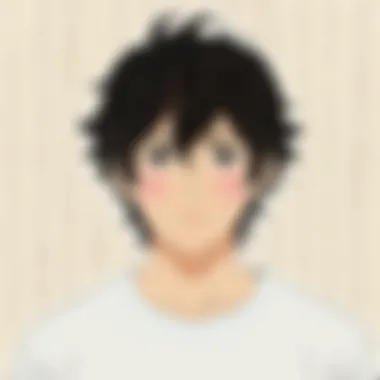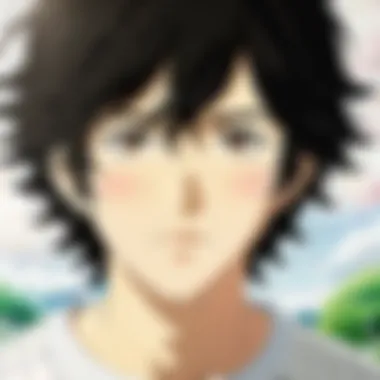Exploring Ao Haru Ride: A Detailed Analysis of Themes


Intro
The world of Ao Haru Ride captivates its audience through a mix of nostalgia, identity, and the tumultuous journey of adolescence. This popular shoujo manga intricately blends the realities of youth with a poignant storyline that resonates deeply. Fans of anime and manga know this series not just as a tale, but as a complex exploration of growing pains, love, and self-discovery.
As we delve into the narrative, we won’t just summarize events; rather, we’ll dissect the elements that make this series special. By peeling back layers of character development and thematic richness, we'll come to appreciate why it holds such significance in the vast landscape of Japanese media. Readers can expect a thorough investigation into the characters’ journeys, the impact of nostalgia, and the universal struggles of finding one's identity.
As we jump into this exploration, we’ll cover key aspects like focusing on episode reviews, character spotlights, the distinct differences between the anime and manga versions, and current industry insights. Join us as we navigate the intricate web that is Ao Haru Ride, recognizing both its emotional depth and cultural relevance in today’s world.
Preface to Ao Haru Ride
Engaging with 'Ao Haru Ride' is akin to flipping through the pages of one's memory. This series doesn't merely exist as a whimsical depiction of romance; it embodies the delicate threads of nostalgia, first love, and the tumultuous journey of adolescence. This importance lies not only in the unfolding romance between Futaba Yoshioka and Kōri Matsumoto but significantly in how the narrative resonates deeply with its audience, capturing the essence of their own experiences.
Overview of the Series
'Ao Haru Ride' was serialized in the esteemed Bessatsu Margaret, bringing a fresh breath of air to the shoujo genre. It navigates the complexities of young love, illuminating the little moments that often slip between the cracks of time. At its core, the story is steeped in the charm of high school life but delves deeper, exploring themes that are far more profound. Futaba, the heroine, is not just a character; she is a reflection of countless girl's bittersweet adolescence. The narrative traverses the highs and lows of relationships, making it relevant to both younger audiences and those who may have long since graduate from high school.
More than a mere love story, 'Ao Haru Ride' examines identity, offers insights into the significance of friendship, and underscores the impact of first loves, vividly reminding readers of what it felt like to be innocent yet confused. The series navigates this careful balance with grace.
Author and Publication History
Written by Io Sakisaka, 'Ao Haru Ride' made its debut in 2011. Sakisaka's unique style combines deft character development with intricate plotting, ultimately crafting a narrative that feels both fresh and familiar. Before this series, Io Sakisaka had already garnered attention with works like Strobe Edge, but this particular title catapulted her into wider recognition. It was serialized until 2014, spanning a total of 13 volumes.
The author’s ability to weave intricate emotions into tender moments is a testament to her understanding of youth. As the pages turned, readers not only followed Futaba's journey but also questioned their own pasts, relating her struggles to their experiences. 'Ao Haru Ride' set a powerful precedent within the genre, distinguishing itself through its authentic portrayal of teenage life.
"True love is just like a fleeting moment captured in time; it is beautiful, yet we're always left wishing for more."
In analyzing this series, the article emphasizes its cultural relevance and its impact on other works, fostering discussions around how such narratives shape and evolve perceptions of young love. The importance of diving deeper into 'Au Haru Ride' is to uncover its layered storytelling that leaves a lasting impression on both its immediate audience and the manga industry as a whole.
Themes Within Ao Haru Ride
Themes play a crucial role in defining the essence of Ao Haru Ride. This series resonates by exploring complex emotional landscapes, inviting readers to reflect on their own experiences. Each theme is intertwined, providing a rich tapestry of storytelling that enhances the narrative depth. By dissecting these themes, one gains insight into the characters and their developments, as well as how these elements interact with the broader context of adolescence.
Nostalgia and First Love
Nostalgia and first love shape the emotional core of Ao Haru Ride. The protagonist, Futaba Yoshioka, embodies the innocence and fervor associated with young love. Readers are drawn into her reminiscences about her first crush, Kōri Matsumoto, and how those memories influence her current relationships. This longing for simpler times is palpable, as the series juxtaposes the past with the complexities of adulthood.
Futaba's journey isn't just about rekindling a flame; it's about reconciling her memories with the present. For many, the feeling of a first love is both exhilarating and bittersweet, and the narrative captures this duality.
"The past is never dead. It's not even past."
- William Faulkner
By weaving this theme of nostalgia throughout the manga, the creators effectively highlight how past experiences shape present realities, illuminating the characters' motivations and choices. This touchstone of nostalgia asks readers to reflect on their own youthful experiences, adding a layer of relatability that is hard to ignore.


Identity and Growth
Identity and growth take center stage as Ao Haru Ride navigates the turbulent waters of adolescence. Futaba's character arc showcases her struggle to forge her own identity amidst societal expectations and peer pressure. The transitions she undergoes—from an awkward middle schooler to a more confident high school student—are significant. This theme invites readers to consider how their identities are shaped not only by their experiences but also by their relationships.
Kōri Matsumoto also illustrates aspects of this theme. His complexities and the emotional baggage he carries reveal a deeper layer of identity exploration. Both characters undergo transformations that reflect broader questions about self-acceptance and personal growth.
As they confront challenges, the narrative emphasizes that growth is not a linear path; it’s filled with setbacks and revelations. This acknowledgment of life's imperfections resonates deeply with audiences, reminding them that self-discovery often involves stepping outside comfort zones.
The Influence of Friendship
Friendship serves as a vital anchor in Ao Haru Ride, showcasing its importance during formative years. The bonds among Futaba, her friends, and even her rivals illustrate a spectrum of relationships that shape individual experiences. Each character's role contributes to Futaba's journey, highlighting that friendships can offer support and guidance but can also lead to misunderstandings and conflicts.
Through these interactions, the narrative delves into the complexities of trust, loyalty, and the repercussions of social dynamics. For instance, the rivalry between Futaba and her peers serves as a backdrop for character development, challenging them to confront their insecurities and prejudices.
At its core, this theme reflects the idea that friendship is a double-edged sword; it can nurture but also hurt. As readers follow the characters' journeys, they are left to ponder their own friendships and the profound impact these relationships have on their lives.
In summary, the themes within Ao Haru Ride coalesce to form a narrative that is rich, relatable, and thought-provoking. Nostalgia, identity, and friendship create a story that mirrors the complexities of youth, making it resonate with enthusiasts and casual readers alike.
Character Analysis
Delving into the characters of Ao Haru Ride offers profound insights into the series' emotional texture. Characters are not mere figures in a narrative; they are the emotional scaffolding that elevates the story. Their interactions, development, and complexity reveal much about the themes of nostalgia, identity, and growth that permeate the work. By examining these characters, we unravel the intricate web of connections and conflicts that form the heart of this shoujo manga, making it essential to a deeper understanding of its impact and appeal.
Futaba Yoshioka: Protagonist Dynamics
Futaba Yoshioka stands as the emotional anchor of Ao Haru Ride. Her character resonates with readers, for she embodies the struggles of adolescence coupled with the search for identity. From the outset, Futaba reveals a desire for acceptance, which many can relate to. However, she grapples with her insecurities, oscillating between confidence and vulnerability. Her transformation is not merely external but deeply internal, showcasing the growth that many young people experience during their teenage years.
- Key traits of Futaba:
- She is often characterized by her awkwardness, which makes her relatable.
- Her growth trajectory reflects a realistic depiction of teenage life, filled with ups and downs.
- The conflict between her true self and how she perceives her friends views her adds a layer of complexity to her character.
Futaba’s evolution throughout the series illustrates the significance of personal growth, urging readers to consider the balance between self-acceptance and the desire to fit in.
Kōri Matsumoto: Complexity of the Love Interest
Kōri Matsumoto serves as more than just the romantic interest in Ao Haru Ride; he is a catalyst for Futaba’s personal development. His enigmatic nature catches the reader's eye and keeps them guessing about his true feelings and motivations. Kōri’s character is intricately crafted; there's a depth to him that unfolds gradually. Where Futaba represents openness and the fear of rejection, Kōri embodies the complexities of communication and unspoken emotions.
He brings significant challenges to Futaba’s life, yet these hurdles are crucial for her growth. Through a series of misunderstandings and heartfelt revelations, readers discover layers to Kōri that make him compelling. His duality makes him a realistic representation of adolescence:
- Contrasts in Kōri’s character:
- He can be both warm and aloof, creating a push-pull dynamic with Futaba.
- His struggle with expressing feelings commonly resonates with young adults.
- Kōri ultimately embodies the concept of growth through vulnerability.
The conflict and chemistry between him and Futaba illuminate the complexities of young love, drawing the audience into their shared journey towards understanding and acceptance.
Supporting Characters and Their Roles


The supporting characters in Ao Haru Ride enrich the narrative, each serving as pivotal players in Futaba's journey. They reflect different facets of youth, from friendship to rivalry. Their unique characteristics contribute to establishing thematic depth and highlight how various interactions shape identities.
Here are a few notable supporting characters:
- Sayaka Miki: A beacon of positivity and confidence, Sayaka challenges Futaba to embrace her true self.
- Toma Kikuchi: Although he has a less prominent role, his interactions with Futaba showcase the nuances of friendship and jealousy. His presence reveals the importance of communication and trust.
- Other classmates: Represent different aspects of school life, adding authenticity to the story. Each character interacts with Futaba in a way that highlights her growth and self-realization.
In this tapestry of characters, the supporting roles deepen the plot and serve as mirrors reflecting Futaba's journey. They underscore the critical nature of relationships during formative years, emphasizing that no one embarks on self-discovery alone.
"In understanding the supporting cast, we see that each character contributes uniquely to the protagonist's development, illustrating that growth is often a collective journey rather than an isolated path."
Through this multifaceted character analysis, we gain insight into the intricacies of Ao Haru Ride, revealing why it resonates with so many on a personal level.
Narrative Structure and Style
The narrative structure and style of Ao Haru Ride play a fundamental role in shaping the overall experience of the series. By intertwining distinct story arcs with relatable character developments, the manga captures the essence of youthful emotions and the inevitable complexities of growing up. Understanding how the story unfolds gives readers more than just a glimpse into the characters' lives; it offers insight into their motivations and challenges, creating an emotional resonance that stays with the reader long after finishing the last chapter.
Plot Progression
In Ao Haru Ride, plot progression is carefully crafted to mirror the developmental stages of its protagonist, Futaba Yoshioka. It’s not just about romantic twists; it also dives into personal growth and self-discovery, as the story fluidly transitions between challenges and moments of clarity.
- The series effectively uses flashbacks to weave past experiences with present situations. This method enriches character backgrounds and provides context for their actions.
- Significant events are timed perfectly within the narrative. For example, the dawn of summer vacation serves as a pivotal point, marking change and prompting introspection for Futaba and her friends.
The pacing is intentional, allowing readers to digest pivotal moments right as they unfold. Moments of heartbreak, joy, or confusion are balanced with quieter, reflective scenes that encourage readers to empathize deeply with the characters. The back-and-forth flow between dramatic episodes and gentler scenes maintains a rhythm that feels both organic and impactful, drawing the audience into a purposefully layered storyline.
Artistic Choices and Visual Storytelling
Artistic choices in Ao Haru Ride are equally essential to the narrative’s depth. Beyond the written word, the illustrations breathe life into the emotional landscapes painted in the storyline. Each panel acts as a canvas showcasing the subtleties of expression and motion that align with the thematic elements of the story.
- Character Design: The characters are rendered with distinct features that reflect their personalities. Take Kōri Matsumoto, whose aloof demeanor is beautifully captured in his sharply defined lines, contrasting Futaba's more rounded and soft design, which resonates with her ongoing struggles against societal expectations.
- Color Palette: While the manga uses primarily black and white art, the impactful use of shading creates depth and conveys emotional weight. Moments of happiness are often presented with more vigorous line work, while scenes of melancholy employ softer tones.
"The visual storytelling in Ao Haru Ride serves as a conduit for emotional connection, illustrating not just actions but reactions and transformations in characters that words alone might not capture."
Additionally, the use of space in the panels promotes a sense of loneliness or crowding depending on the scene’s context, effectively enhancing the narrative's emotional impact. The interplay of dialogue and visual representations presents a rich tapestry that immerses readers in both the plot and the characters’ journeys.
Cultural Impact
The cultural significance of Ao Haru Ride extends far beyond its pages, resonating deeply with a multitude of audiences. The narrative not only captivates through its engaging storyline but also holds a mirror to the realities of adolescence, making it relatable to many young readers. This section explores how the series has influenced popular culture, particularly within the realm of shoujo manga and anime, while also considering its reception and the adaptations that have sprung from it.
Reception by Critics and Fans
Ao Haru Ride has garnered both acclaim and critique since its debut. Critics often commend the series for its sincere portrayal of teenage emotions, deftly capturing the turbulence of first love and personal growth. Many enthusiasts point out that it reflects their own life experiences, thus creating a bond between the reader and the story.
The manga has received various accolades throughout the years. For instance, it was nominated for the Kodansha Manga Award, showcasing its importance in the competitive landscape of manga. Fans often take to forums like Reddit to discuss their favorite moments, with numerous threads dedicated to its characters and romantic developments.


"This manga identifies moments of my youth I thought were lost to time. It's like looking back and seeing that I wasn't alone in my experiences during high school."
— A devoted fan review, shared on an anime community platform.
The emotional depth of the characters, especially Futaba Yoshioka, has led to a wide array of interpretations and analyses among its fanbase. Many cite her character arc as a beacon of resilience and growth, making her journey captivating.
Adaptations and Expanded Universe
Following its success in print, Ao Haru Ride made the leap to animated television. The anime adaptation, produced by Production I.G, brought the vibrant world to life, resonating with both long-time fans and new viewers alike. The transition from manga to anime was widely welcomed, although purists sometimes express their reservations about certain plot alterations. The series was characterized by its delicate art style and evocative soundtracks, which enhanced the emotional beats of the story.
In addition to the anime, there have been discussions about spin-offs and adaptations into other media, including theatrical adaptations and merchandise. One notable mention is the live-action film that further popularized the series, helping it reach audiences unfamiliar with the manga.
The expanded universe of Ao Haru Ride also encourages discussions among fans. Numerous fan-made works, including fan art and stories, blossom online, demonstrating how the characters have inspired creativity and engagement. The community surrounding the series helps maintain its relevance, fostering an environment where discussions about themes, characters, and narratives thrive.
In summary, the cultural impact of Ao Haru Ride is manifested in its reception and adaptations. It not only serves as a source of entertainment but also as a reflective piece that many personalize by recalling their experiences during adolescence. The series continues to inspire discussions and adaptations, making it a cornerstone of contemporary shoujo culture.
Comparative Analysis
In the realm of shoujo manga, "Ao Haru Ride" stands out, not merely as an isolated work but within a broader tapestry of narratives sharing the same genre. This section holds vital importance as it examines how this series interacts with its counterparts. By engaging in a comparative analysis, we can understand the unique attributes of "Ao Haru Ride" while also appreciating the dynamics that define contemporary shoujo manga. Such analysis offers a dual lens: one that focuses on the qualities that set this series apart and another that contextualizes it within ongoing genre trends.
Ao Haru Ride vs. Other Shoujo Works
"Ao Haru Ride" often draws comparisons with other notable shoujo manga like "My Little Monster" and "Kimi ni Todoke." While each of these series engages with themes of romance and growth, the execution varies significantly. Here’s a look at its core differences and similarities:
- Theme Depth: Unlike other works that sometimes skirt the edges of emotional complexity, "Ao Haru Ride" delves into deeper issues of nostalgia and self-identity. Its protagonist, Futaba Yoshioka, navigates through past love and the societal pressures that shape her high school experience, a layer not as extensively explored in many other shoujo narratives.
- Realism vs. Idealism: Earlier series often veer towards idealism, creating romantic scenarios that, while captivating, feel somewhat surreal. In contrast, "Ao Haru Ride" features a more realistic portrayal of young love, highlighting imperfections and conflicts. This gives it a relatability factor that resonates with readers.
- Character Dynamics: Focusing on the development of its characters, "Ao Haru Ride" exhibits nuances in relationships, particularly how friendships influence romantic decisions. Characters are not just vessels for romance; they grow and evolve over time, leading to a more engaged readership.
As we dissect these comparative points, they reveal how "Ao Haru Ride" enriches the shoujo landscape by infusing familiar tropes with fresh perspectives. It’s crucial to recognize that these elements contribute to the series' enduring appeal and success.
Influence on Contemporary Anime and Manga
The influence of "Ao Haru Ride" extends well beyond its pages, impacting contemporary anime and manga. As the genre of shoujo continues to evolve, this series has set a benchmark for how emotional storytelling can be integrated into animation and storytelling across the board.
- Narrative Techniques: The blend of humor and drama in "Ao Haru Ride" is a strategy that has influenced newer works, encouraging creators to strike a balance between lighthearted moments and serious themes. This approach provides a vivid spectrum that appeals to a wide audience.
- Character Archetypes: Several series following "Ao Haru Ride" reflect its character development strategy. The complexity of protagonist dynamics can be seen in other works that prioritize multi-dimensional characters rather than relying on archetypes alone.
- Market Trends: The success of "Ao Haru Ride" spurred a rise in narratives that explore adolescent turmoil and identity crises. Many creators now weave these themes into their work, aiming to capture that same depth of emotion and authenticity.
In synthesis, the comparative analysis not only highlights how "Ao Haru Ride" stands out against its peers, but it also showcases its impact on the genre, influencing future works and shaping audience expectations. Viewing the series through this lens enriches our understanding of its critical acclaim and enduring legacy.
"Understanding how a series fits into a larger context can illuminate its significance in both the genre and cultural representation as a whole,"
— Scholar on contemporary manga.
Closure
As we wrap up this exploration of Ao Haru Ride, it becomes clear that the significance of the series reaches far beyond its pages. This conclusion serves as a testament to the rich layers of themes it presents and the lasting impact it has on readers.
Final Thoughts on Ao Haru Ride
When considering Ao Haru Ride, one must reflect on the journey of Futaba Yoshioka, our protagonist, who mirrors the experiences of so many in the throes of change and self-discovery. The manga's ability to evoke nostalgia for first loves, alongside the emotional turbulence of adolescence, makes it a relatable piece for various age groups. Its nuanced characters and relatable scenarios pave the way for dialogues around identity and growth. We can see that mistakes and misunderstandings, often signs of youth, actually serve as crucial catalysts for personal development. In essence, Ao Haru Ride isn’t merely a story about romance; it’s a vivid portrayal of the messiness of growing up.
The Legacy of the Series
The legacy that Ao Haru Ride leaves behind in the shoujo landscape is undeniable. It has influenced numerous contemporary works, ushering in a trend of more profound character development and complex storytelling. Its cultural resonance continues to echo, prompting discussions in online communities and forums, like those found on Reddit.
Within the intricate dances of shoujo romances, the heart of Ao Haru Ride beats compellingly, capturing the challenges and triumphs of youthful love.
For many fans, whether reading the manga or following the anime adaptation, Ao Haru Ride has become more than entertainment; it's a reflection of life’s own trials and joys. With conversations stoked by its themes, the series invites ongoing reflection, making it a remarkable piece in the broader canon of Japanese media. As the waves of nostalgia continue to wash over fans new and old, it reinforces its place in the hearts of many and solidifies its legacy in the cultural tapestry of anime and manga.







